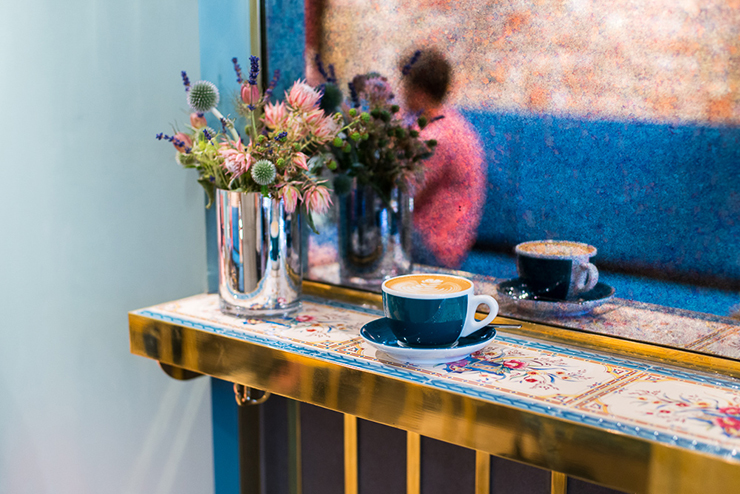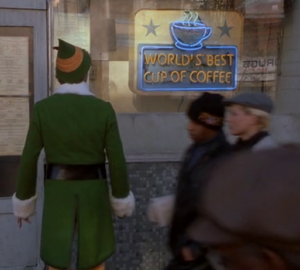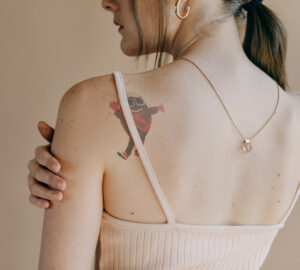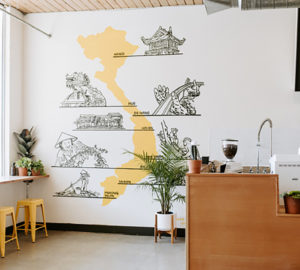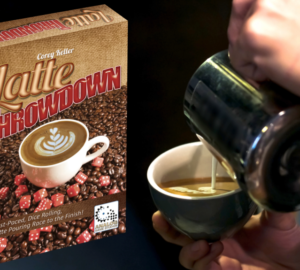It’s been a monster year already for our friends and partners at Workshop Coffee in London, who’ve opened not one but two new cafes so far in 2014, in the city’s Fitzrovia and Holborn neighborhoods. Amid the din and hum of running four busy coffee bars across London (not to mention a coffee buying trip to Kigali), Workshop’s Director of Operations, Tim Williams, and Executive Director, James Dickson, somehow made time to sit down digitally with Sprudge for a freewheeling series of email interviews.
Want to know what it’s like to run a prominent London specialty coffee company? Here’s news from inside the storm, accompanied by photos of their new shop in Fitzrovia from Sprudge London contributor Giulia Mule.
We’re always curious to ask shop owners about intentionality — talk to us about the decisions behind your gear choices at Workshop Fitzrovia. From the photos we’re spying La Marzocco and Mazzer espresso making equipment, a Mahlkonig EK43 grinder, Marco Uber Boiler hot water taps, AeroPress service…
Tim Williams: We like equipment that works, equipment that we can trust, and equipment that lets our staff provide both great coffee and great hospitality to our guests. We find that the La Marzocco Linea PB not only enable our staff to spend more time talking to guests, but delivers a more consistently delicious espresso across a number of locations than other machines we’ve used in the past. There’s great service and support for the La Marzocco equipment, too, which has been crucial as we’ve grown. We’ve had issues in the past with the maintenance and servicing of espresso equipment, and it’s a headache that no-one needs. It’s fine for your espresso machine to look like a hot rod, but in honesty, you want it performing like a Volkswagen; consistently and reliably. That’s what we have with La Marzocco.
On the hot rod tip, we’ve had solid brass custom badges made for all our machines in the LM factory, which is the kind of responsiveness and help we really appreciate.
The EK43 / Uber Boiler / AeroPress combination is one that we’ve had in all our stores for quite a while now. I think we ditched pour over brewing back in 2012, in favour of the AeroPress exclusively and have never looked back. It sounds like the trotting out of a series of very predictable and staid cliches to say; a) it brews great coffee, b) it’s the brewer most of us use at home, and c) it’s easy to learn, travel with, clean etc. etc., but they’re all true.
We like the clarity and spectrum of flavour that we get from the EK43, over other grinders that we’ve used in the past. We used the EK43 first in our cupping space, and then found that we didn’t enjoy the results in stores nearly as much, so we switched them all out to the EK43 too, and have had great results. The only annoying thing is having to peel Matt Perger’s stickered face off the side of every new one, as much as I love the guy.
After spending time in New York last year, and tasting the way the Heart Coffee Roasters‘ coffee was coming up at Ports, we added Fetco batch brewers into our range at our two newest stores. Looking back, I wish we’d done this a lot earlier, as the results that we’re getting off these are really great and we’re able to offer incredible coffees at a much lower price point. We’re looking into how we’ll work the Fetcos into the set ups at our two original stores, as we’re a little tight on space at them both. I’m sure we’ll sort it, though.
Looking at photos of Fitzrovia, it has more of a parlor feel than Workshop Holborn, which is located in the lobby of a tech building. I’m thinking about the tile on the condiments bar, and the small cluster of inward facing seating and tables. What’s the intention behind that?
James Dickson: It’s a really interesting design; the vision was inspired by a fusion of the old Victorian era with a bohemian twist. Essentially, we are paying homage to the history of the area which was the avant garde area of London and an intellectual meeting point for the ‘progressive’ Londoner. This was mixed in with “the expansion of the British Empire” in that time and the use of foreign and exotic materials and patterns….hence the tiles.
TW: I’ll offer up something on the seating; while we love our Marylebone coffeebar dearly, I think we missed a trick by putting all the seating facing outwards or towards the walls. Very few people choose to sit as the seating would dictate, and instead tend to focus in to the middle of the store to converse, or even just to watch what’s happening. We learned from that, and chose to focus on it, and make the seating area of Fitzrovia a nice little secluded nook, quite private like an old smoking lounge of a great London hotel, and hoped that it would facilitate conversation and interaction amongst a fairly reserved and staid population. So far, it’s working really well, and it’s probably my favourite of our spaces to drink coffee in.
Good heavens those are some turquoise walls! Is Workshop Fitzrovia the most turquoise cafe in London?
JD: Ha! We had numerous debates with our designers, Ink Associates on this. I’m voting for a more ‘teal’ colour befitting of the Victorian era…rather than strong turquoise.
All four of your previous cafes are quite different from one another — let’s play a game with that. Think about all 4 cafes, and give me a word or phrase that you think sums them up best.
JD: Workshop Clerkenwell = “Trendy, experimental, Brooklyn NYC…yes we do like to flatter ourselves every now and again!”
Workshop Marylebone = “Clean, warm, cute and adorable.”
Workshop Holborn = “Slick, masculine, minimal, the future of coffee bar design.”
Workshop Fitzrovia = “Classy, opulent, quite serious and professional.”
For Fitzrovia, do a bit of scene setting for our readers in Kuala Lumpur or whatever — what’s the neighborhood like? Who is coming into this shop everyday?
JD: Great question. A part of me wants to say Charles Dickens meets Steve Jobs. Historic and traditional ‘suits’ interact with modern fashion designers, alternative hedge fund traders and uber-energised spinners who just love their coffee before cycling. In a nutshell, it’s a melting pot, a neighbourhood full of surprises and everybody is really friendly. We like it.
Tim, you were on the forefront of bringing good coffee to London at a cafe called Flat White, part of a small but mighty wave of Aussies who transformed the city’s landscape fairly quickly over the course of the last decade. Do you still see that Australian influence in London? Has the wider influence of Australians in London coffee faded or become more blurred, or is it still quite distinct?
TW: I think the whole Australian thing is starting to become a bit more nebulous, a bit more of a distant causality rather than the primary thing that journalists or punters gravitate to. And about time, too. I happen to be Australian and still love the country, but I left there a very long time ago. And while Australians have certainly had a big influence on what’s happened in London and UK coffee over the last few years, to isolate it as the cause of good coffee unfairly discounts the involvement of people like James Hoffmann, Anette Moldvaer and Stephen Morrissey at Square Mile, of Anita le Roy from Monmouth, of Steve Leighton at HasBean and so many more.
I mean, that’s not even to mention the fact that, from a personal perspective, I’ve been influenced greatly by time spent traveling and working in Portland, Los Angeles, New York, Oslo, Copenhagen. London is such a multi-faceted city, comprised of such a rich and interesting mix of cultures and heritages that it was terrifying to see a kind of haphazardly transplanted, faux-Australianism being foisted so aggressively onto its coffee-drinking, cafe-going population. The reality is, even the Australian-themed cafes of London have nothing of the feel or atmosphere of their originators in Melbourne or Sydney. You can’t fake it, and I personally don’t think you should try.
Luckily, I think London’s finding a bit of its own groove these days, and coming into some kind of maturity as an industry. Now we’re starting to see places opening that have their own feel, their own energies and the cafe scene is becoming ever the richer for it.
If you could open your 5th cafe anywhere in the world, where would it be and why?
TW: Professionally speaking, New York; because it’s an amazing city, and visiting once a year is nowhere near often enough. Personally speaking, Melbourne; so I could spend more time with my sister and her beautiful family.
Say I’m some clueless American just off the jet — give me three cafes in London I positively should not miss (be as immodest as you wish).
TW: Stop One: Morning coffee at Workshop Fitzrovia; it’s a beautiful space, the coffee is great and it’s smack bang in the centre of the capital of the World.
Stop Two: Lunch at M1LK; a fantastic cafe down south in Balham that serves our coffee really nicely, alongside Koppi from Sweden, with a really great aesthetic and incredibly fun and inventive food.
Stop Three: An afternoon at the bar at St. John; while technically not a cafe, you can get coffee there (I wouldn’t recommend it), but the food, the wine and the gin are all spectacular. It’s a must visit for every single guest that comes through London, and being just a few doors down from our office, we tend to hold meetings, staff evaluations and Friday afternoon drinks there very often.
Thank you for your time.
Original photos by Giulia Mule for Sprudge.com.















